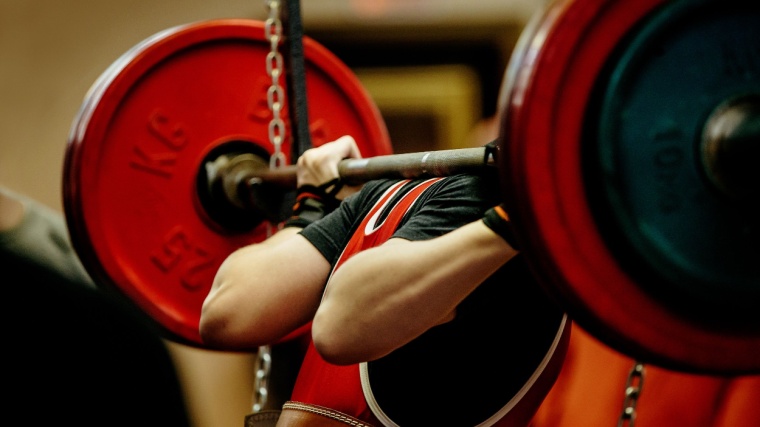Barbell squats are a must-do leg exercise. Somewhere along the way, it seems like everybody moved on from what was long considered the de facto lower-body movement.
- Many bodybuilding pros eschew the barbell squat for the hack squat, pendulum squat, or Smith-machine-something during their leg workouts. If you’ve got your IFBB pro card, that’s all well and good.
But for (almost) everybody else, barbell squats are a must-do.

5 Reasons Why You Must Do Barbell Squats on Leg Day
I’m not ashamed to say how tired I’ve grown of the optimization-ization of bodybuilding training. Content creators have butter to churn; if you’re in the business of peddling fitness advice, you can only make so many Reels or TikToks about squats before your audience tires of you beating that drum.
- The drum, like the barbell squat, was invented a long time ago and works just as well now as it did during the dark ages.
Modern muscle-building science is all about compartmentalization. Remove as many moving parts as possible, isolate the target tissue as precisely as possible, and damn the rest. Sounds good on paper, but in practice this is a recipe for fragility and, over a long-enough timeframe, subpar gains.
Here are five reasons why you must do some form of barbell squat on leg day if you’re able:
[Related: Best Pre-Workout Supplements for Leg Day]
1. Squats Build More Strength
If you’re a powerlifter or Olympic lifter, this isn’t news: Free-weight, two-legged squatting is unequivocally the best way to build maximal lower body strength. It is for that reason that the squat is an entire third of powerlifting as well as being a mainstay movement in the off-season training plans for athletes in nearly every sport.
- One study from 2016 looking at the barbell squat and leg press concluded that squats, “increased [strength and power] performance … more effectively compared with the leg-press…” (1)
“But look how heavy I’m lifting on the leg press!” You say, hauling yet another 45-pound plate over and sliding it on before sitting comfortably in a seat and bending your knees a few inches.
If “how many plates can I steal from other gymgoers” was a good way to get strong, doing above-the-knee rack pulls would make you a world-class deadlifter.
[Related: Best Squat Racks, Tested by Experts]
2. Top-Tier Muscle Activation
Barbell squats are the perfect middle ground for muscle activation. Leg extensions remove all moving parts except for your quads, but you can’t work with heavy weights. Leg pressing lets you stack up as many plates as your ego yearns for, but aren’t very “functional.”
Free-weight squats fall right in the middle; they produce tremendous amounts of leg muscle activation but aren’t too niche or acrobatic to be practical.
- One study in the Journal of Strength and Conditioning Research found that “[the barbell squat] elicits higher overall [muscle activation] than squats in a Smith machine, leg press, and leg extension.” (2)
There’s one caveat worth mentioning; the standard barbell squat is a poor hamstring exercise. Unless you perform low bar squats with an extremely pronounced hip hinge, you probably aren’t going to get a good hammy workout from squatting.
[Related: Best Creatine Supplements for Muscle Growth]
3. Carryover to Other Exercises
The barbell squat isn’t just a leg exercise for muscle growth; it’s a foundational movement pattern. The strength, size, and skill you develop from squatting carries over to other leg exercises, but the benefits don’t flow both ways. At least, not nearly as well.
Here’s friend of BarBend and 2023 World’s Strongest Man Mitchell Hooper, discussing the flow of strength between the barbell squat and a similar machine-based exercise:
- “Leg pressing may make your legs stronger on the leg press, but does that mean you can coordinate your other muscles in the same way in a free-weight squat pattern? It’s probably not going to be as effective.”

Hooper continued: “Muscle mass gives you the potential to exploit a skill, but strength training is a skill.” Building as much mass as possible is a perfectly reasonable goal for a bodybuilder — if you’re not trying to go pro, there’s no reason to cast aside other elements of athleticism along the way.
(Fun fact: Hooper hates above-the-knee rack pulls for this reason. BarBend even debated him about it once. All told, we lost that argument.)
[Related: Best Weightlifting Belts for Leg Day]
4. Efficient Use of Gym Time
We aren’t all blessed with infinite free time to spend in the weight room every day. For the time-poor, there’s no better way to guarantee gains than building your leg day around the squat.
Squats hit almost every mark of a good leg workout at once; they build robust and functional strength, absolutely thrash your quads, glutes, adductors, and core, and train your hip, knee, and ankle joints through a full range of motion.
You can waltz into the gym, squat for 20 or 30 minutes, and leave knowing you’ve covered your bases more than adequately.
- In fairness, more isn’t always more. Barbell squats suffer from the same diminishing returns as any other exercise. If you aren’t doing any free-weight bilateral squats — that’s the back or front squat, overhead squat, Zercher squat, and I guess we’ll chuck goblet squats in there — adding a few hard sets each week will go a long way.
But if you’re already squatting twice per week, anteing up won’t give you the same return on your investment.
5. Squats Are Cool
Nothing turns heads in the weight room like absolutely burying a heavy squat. Bodybuilding greats — Tom Platz made squatting his whole brand, while Jay Cutler endorses barbell squats as his number-one leg exercise overall — love them, and we’ve all seen pro Olympic lifters make 500-pound squats look like an empty bar.
- Of course, coolness doesn’t build muscle or strength. But there’s something to be said for having an exercise in your program that you can be proud of.
When you’re inevitably dragged into an awkward conversation about your gym career, you won’t be asked how much you can lift on the leg press. The barbell squat is a craft — mastering it shows you mean business in the weight room.
[Related: Best Supplements for Bodybuilding Workouts]
More Training Content on BarBend
- 5 Science-Based Hacks for Muscle Growth That Actually Work
- The “4+1” Protocol for Easy-Mode Calf Gains
- The Laziest Way To Do More Pull-Ups
References
- Wirth K, Hartmann H, Sander A, Mickel C, Szilvas E, Keiner M. The Impact of Back Squat and Leg-Press Exercises on Maximal Strength and Speed-Strength Parameters. J Strength Cond Res. 2016 May;30(5):1205-12. doi: 10.1519/JSC.0000000000001228. PMID: 26439782.
- Clark, Dave R.; Lambert, Mike I.; Hunter, Angus M.. Muscle Activation in the Loaded Free Barbell Squat: A Brief Review. Journal of Strength and Conditioning Research 26(4):p 1169-1178, April 2012. | DOI: 10.1519/JSC.0b013e31822d533d
Featured Image: Veles Studio / Shutterstock